四年级下册英语第8课课文
PEP小学四年级英语下册课文翻译

PEP四年级英语下册课文及翻译Unit One My school 第一单元我的学校Look!That’s the playground。
看!那是操场。
Where’s the library?.图书馆在哪儿?It’s next to the art room. 它在美术室的旁边.Oh,No!That’s my library! 哦!不!那是我的图书馆!Is this the teachers’ office?这是老师的办公室吗?.No,it is n’t.It’s the computer room. 不,它不是。
它是电脑室。
Do you have an art room? 你们有美术室吗?Yes.It’s on the second floor. 有的,它在二楼.Let’s talk让我们来对话吧Excuse me 。
Where’s the teachers’ office?对不起,老师的办公室在哪儿?It's on the second floor. 它在二楼.Ok。
Thanks. 谢谢!Hi,Is this the teachers’ office? 嗨!这是老师的办公室吗?No,it is n’t。
The teachers' office is next to the library.不,不是的。
老师的办公室在图书馆旁边。
Hi,Miss White!Here’s my homework.你好,怀特小姐!这是我的家庭作业. Thank you,Mike.谢谢你,麦克。
Bye,Miss White.再见,怀特小姐.Look,ask and answerWhere’s the library?图书馆在哪里?It’s on the second fl oor。
它在二楼。
Is it next to classroom 3? 它是在三班的旁边吗?Yes,it is. 是的.Let’s learnWhere's the library?【teachers’ office】图书馆在哪里?/老师的办公室It’s on the first floor。
(完整版)PEP小学四年级下册英语课文及翻译

PEP四年级下册英语课文及翻译Unit 1 Our schoolA Let’s learnplayground操场library图书馆teacher’s office 教师办公室garden花园canteen食堂Where is the canteen?食堂在哪里?It’s on the first floor.它在一楼。
Let’s doGo to the garden. Water the flowers.Go to the library. Read a story-book.Go to the cinema. Eat some noodles.Go to the teacher’s office. Hand in your homework.Go to the playground. Play football.Let’s talkChen: Welcome to our school! 欢迎来我们的学校。
This is the teacher’s office.这是教室办公室。
That is my classroom.那是我的教室。
Visitor: How many students are there in your class?你们班有多少个学生?Chen: Forty-five.四十五。
Visitor: Do you have a library?你们有图书馆吗?Chen: Yes.Visitor: Do you have lunch at school?你们在学校吃午饭吗?Chen: Yes! The canteen is on the first floor. This way , please.是的。
食堂在一楼。
这边请。
Look! This is our playground.看!这是我们的操场。
Visitor: Oh! Your school is beautiful.哦!你们的学校很漂亮。
人教版四年级下英语课文
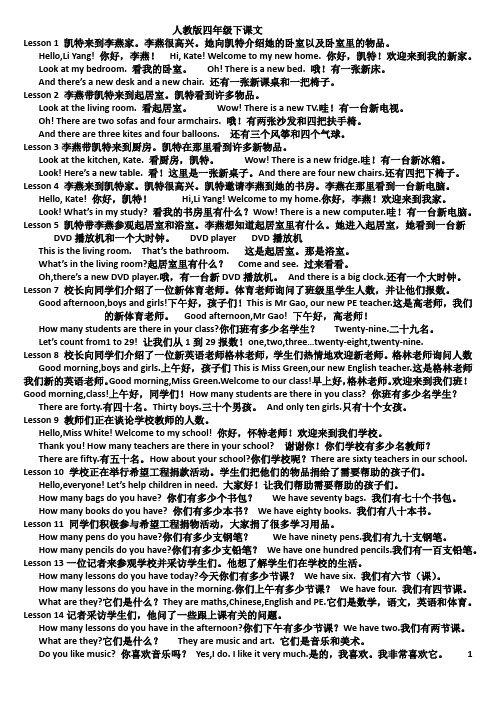
人教版四年级下课文Lesson 1凯特来到李燕家。
李燕很高兴。
她向凯特介绍她的卧室以及卧室里的物品。
Hello,Li Yang! 你好,李燕!Hi, Kate! Welcome to my new home. 你好,凯特!欢迎来到我的新家。
Look at my bedroom. 看我的卧室。
Oh! There is a new bed. 哦!有一张新床。
And there’s a new desk and a new chair. 还有一张新课桌和一把椅子。
Lesson 2 李燕带凯特来到起居室。
凯特看到许多物品。
Look at the living room. 看起居室。
Wow! There is a new TV.哇!有一台新电视。
Oh! There are two sofas and four armchairs. 哦!有两张沙发和四把扶手椅。
And there are three kites and four balloons. 还有三个风筝和四个气球。
Lesson 3李燕带凯特来到厨房。
凯特在那里看到许多新物品。
Look at the kitchen, Kate. 看厨房,凯特。
Wow! There is a new fridge.哇!有一台新冰箱。
Look! Here’s a new table. 看!这里是一张新桌子。
And there are four new chairs.还有四把下椅子。
Lesson 4 李燕来到凯特家。
凯特很高兴。
凯特邀请李燕到她的书房。
李燕在那里看到一台新电脑。
Hello, Kate! 你好,凯特!Hi,Li Yang! Welcome to my home.你好,李燕!欢迎来到我家。
Look! What’s in my study? 看我的书房里有什么?Wow! There is a new computer.哇!有一台新电脑。
Lesson 5 凯特带李燕参观起居室和浴室。
四年级下册英语第八课

四年级下册英语第八课In the eighth lesson of English for the fourth grade, students will learn about different types of festivals celebrated around the world. This lesson aims to broaden their cultural knowledge and enhance their understanding of diverse traditions. The following text will delve into the content covered in this lesson, without repetition of the title or any unnecessary phrases, while maintaining a cohesive flow throughout.In this lesson, students will be introduced to various festivals celebrated in different countries. Festivals are important cultural events that bring people together to celebrate and have fun. They are often characterized by unique traditions, such as special food, music, dances, and customs.The first festival showcased in this lesson is Halloween, which originates from the Celtic festival of Samhain. On October 31st, people in many English-speaking countries, especially the United States, will carve pumpkins into jack-o'-lanterns, wear costumes, and go trick-or-treating. Halloween is a time when people enjoy dressing up as their favorite characters and indulge in sweets and treats.Moving on, the lesson introduces Diwali, also known as the Festival of Lights. Diwali is widely celebrated in India and marks the victory of light over darkness. During this festival, people light oil lamps, called diyas, in their homes to symbolize the triumph of good over evil. Fireworks, delicious sweets, and exchanging gifts are also common traditions during Diwali.Next, the lesson explores the Japanese festival of Tanabata, which takes place on July 7th. This festival celebrates the reunion of two mythical lovers,represented by the stars Vega and Altair. People write their wishes on colorful pieces of paper and hang them on bamboo trees in the hopes of having them come true. The streets are beautifully decorated with colorful streamers, and vibrant parades and fireworks add to the festive atmosphere.Another festival covered in this lesson is Chinese New Year, also known as Spring Festival. This festival is the most important and longest celebration in Chinese culture, lasting for 15 days. It usually falls between January 21st and February 20th. Chinese New Year is a time for family reunions, feasting, and honoring ancestors. Fireworks, dragon and lion dances, red decorations, and giving out red envelopes containing money as gifts are significant customs observed during this festival.Lastly, the lesson discusses Thanksgiving, a major holiday in the United States and Canada. It is celebrated on the fourth Thursday in November in the US and the second Monday in October in Canada. Thanksgiving is a time when families come together to give thanks for the blessings in their lives, especially the harvest. Roasted turkey, cranberry sauce, pumpkin pie, and mashed potatoes are traditional foods enjoyed during Thanksgiving dinner. Parades, football games, and expressing gratitude are also part of the festivities.In conclusion, the eighth lesson of the fourth grade English curriculum focuses on various festivals celebrated worldwide. Halloween, Diwali, Tanabata, Chinese New Year, and Thanksgiving were explored in this lesson, allowing students to gain a deeper understanding of different cultures and their unique traditions. Festivals serve as valuable opportunities tostrengthen cultural awareness and appreciation, fostering a sense of unity and respect among people of diverse backgrounds.。
部编版四年级下册语文第8课《千年梦圆在今朝》课文原文及知识点
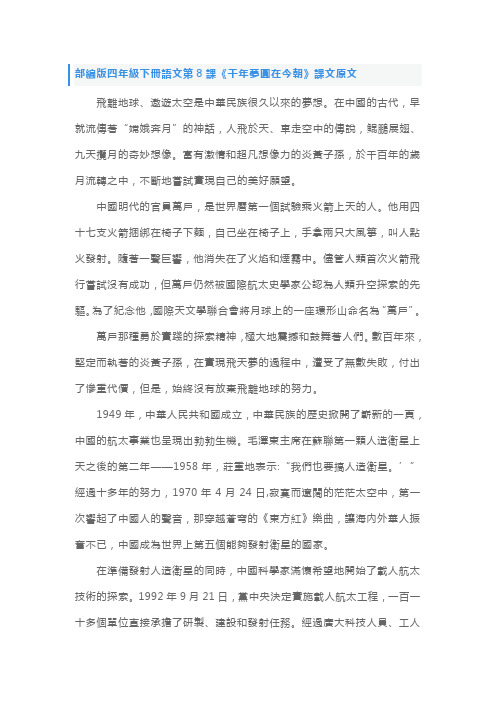
部編版四年級下冊語文第8課《千年夢圓在今朝》課文原文飛離地球、遨遊太空是中華民族很久以來的夢想。
在中國的古代,早就流傳著“嫦娥奔月”的神話,人飛於天、車走空中的傳說,鯤鵬展翅、九天攬月的奇妙想像。
富有激情和超凡想像力的炎黃子孫,於千百年的歲月流轉之中,不斷地嘗試實現自己的美好願望。
中國明代的官員萬戶,是世界曆第一個試驗乘火箭上天的人。
他用四十七支火箭捆綁在椅子下麵,自己坐在椅子上,手拿兩只大風箏,叫人點火發射。
隨著一聲巨響,他消失在了火焰和煙霧中。
儘管人類首次火箭飛行嘗試沒有成功,但萬戶仍然被國際航太史學家公認為人類升空探索的先驅。
為了紀念他,國際天文學聯合會將月球上的一座環形山命名為“萬戶”。
萬戶那種勇於實踐的探索精神,極大地震撼和鼓舞著人們。
數百年來,堅定而執著的炎黃子孫,在實現飛天夢的過程中,遭受了無數失敗,付出了慘重代價,但是,始終沒有放棄飛離地球的努力。
1949年,中華人民共和國成立,中華民族的歷史掀開了嶄新的一頁,中國的航太事業也呈現出勃勃生機。
毛澤東主席在蘇聯第一顆人造衛星上天之後的第二年——1958年,莊重地表示:“我們也要搞人造衛星。
’”經過十多年的努力,1970年4月24日,寂寞而遼闊的茫茫太空中,第一次響起了中國人的聲音,那穿越蒼穹的《東方紅》樂曲,讓海內外華人振奮不已,中國成為世界上第五個能夠發射衛星的國家。
在準備發射人造衛星的同時,中國科學家滿懷希望地開始了載人航太技術的探索。
1992年9月21日,黨中央決定實施載人航太工程,一百一十多個單位直接承擔了研製、建設和發射任務。
經過廣大科技人員、工人和解放軍官兵十餘年的不懈努力,2003年10月15日早晨9時,在酒泉衛星發射中心,隨著一聲震耳欲聾的巨響,我國自行研製的“神舟五號”飛船被送上太空。
火箭宛若一條蜿蜒的巨龍,劃過一道絢麗的曲線,瞬間便消失在了蒼穹之中。
10月16日6時23分,飛船在環繞地球十四圈後成功返回著陸場。
太空人楊利偉在即將登機返回北京的時候,用三句話概括了他二十一小時的太空旅行:“飛船飛行正常。
2020春四年级英语下册Unit8Howareyou第1课时教案说课稿(新版)牛津译林版
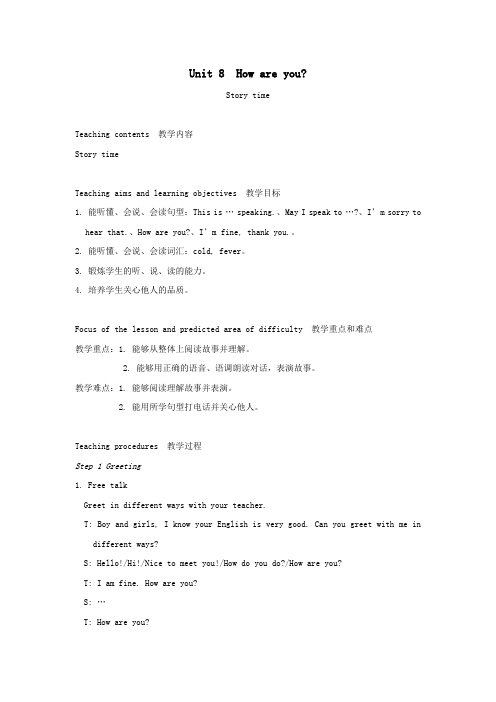
Unit 8 How are you?Story timeTeaching contents 教学内容Story timeTeaching aims and learning objectives 教学目标1. 能听懂、会说、会读句型:This is …speaking.、May I speak to …?、I’m sorry tohear that.、How are you?、I’m fine, thank you.。
2. 能听懂、会说、会读词汇:cold, fever。
3. 锻炼学生的听、说、读的能力。
4. 培养学生关心他人的品质。
Focus of the lesson and predicted area of difficulty 教学重点和难点教学重点:1. 能够从整体上阅读故事并理解。
2. 能够用正确的语音、语调朗读对话,表演故事。
教学难点:1. 能够阅读理解故事并表演。
2. 能用所学句型打电话并关心他人。
Teaching procedures 教学过程Step 1 Greeting1. Free talkGreet in different ways with your teacher.T: Boy and girls, I know your English is very good. Can you greet with me in different ways?S: Hello!/Hi!/Nice to meet you!/How do you do?/How are you?T: I am fine. How are you?S: …T: How are you?S: …T: I am happy to hear that. And today we will learn Unit 8 How Are you? Show and read the title.【设计意图:课堂伊始,通过让学生用不同的方式向老师打招呼,引出本课课题,让学生在轻松愉悦的环境中进入本节课的学习。
冀教英语四年级下册第8课课文朗读翻译重难点讲解
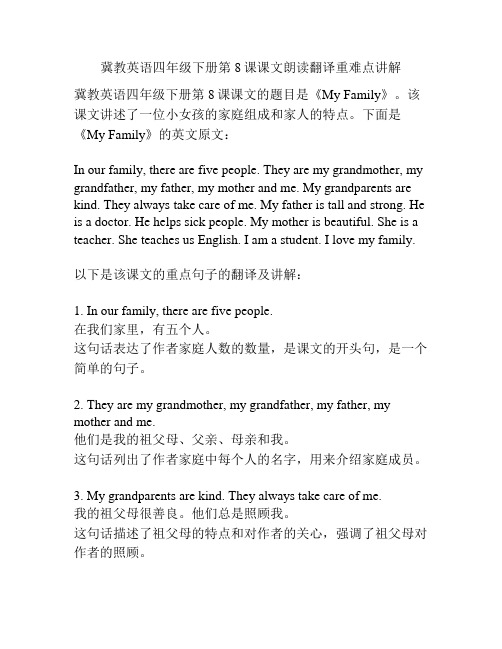
冀教英语四年级下册第8课课文朗读翻译重难点讲解冀教英语四年级下册第8课课文的题目是《My Family》。
该课文讲述了一位小女孩的家庭组成和家人的特点。
下面是《My Family》的英文原文:In our family, there are five people. They are my grandmother, my grandfather, my father, my mother and me. My grandparents are kind. They always take care of me. My father is tall and strong. He is a doctor. He helps sick people. My mother is beautiful. She is a teacher. She teaches us English. I am a student. I love my family. 以下是该课文的重点句子的翻译及讲解:1. In our family, there are five people.在我们家里,有五个人。
这句话表达了作者家庭人数的数量,是课文的开头句,是一个简单的句子。
2. They are my grandmother, my grandfather, my father, my mother and me.他们是我的祖父母、父亲、母亲和我。
这句话列出了作者家庭中每个人的名字,用来介绍家庭成员。
3. My grandparents are kind. They always take care of me.我的祖父母很善良。
他们总是照顾我。
这句话描述了祖父母的特点和对作者的关心,强调了祖父母对作者的照顾。
4. My father is tall and strong. He is a doctor. He helps sick people. 我的爸爸又高又壮。
冀教英语四年级下册第8课课文朗读翻译重难点讲解
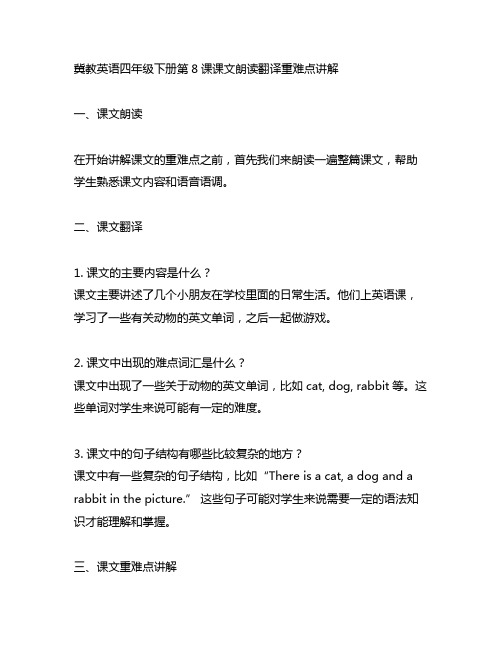
冀教英语四年级下册第8课课文朗读翻译重难点讲解一、课文朗读在开始讲解课文的重难点之前,首先我们来朗读一遍整篇课文,帮助学生熟悉课文内容和语音语调。
二、课文翻译1. 课文的主要内容是什么?课文主要讲述了几个小朋友在学校里面的日常生活。
他们上英语课,学习了一些有关动物的英文单词,之后一起做游戏。
2. 课文中出现的难点词汇是什么?课文中出现了一些关于动物的英文单词,比如cat, dog, rabbit等。
这些单词对学生来说可能有一定的难度。
3. 课文中的句子结构有哪些比较复杂的地方?课文中有一些复杂的句子结构,比如“There is a cat, a dog and a rabbit in the picture.” 这些句子可能对学生来说需要一定的语法知识才能理解和掌握。
三、课文重难点讲解1. 课文中的重点词汇讲解在这部分,我们可以针对课文中出现的重点词汇进行详细的讲解和示范。
比如通过图片、动作等方式,帮助学生理解和记忆课文中的关键词汇。
2. 课文中的重点句子结构讲解针对课文中的复杂句子结构,我们可以通过拆分句子、举例说明等方式,帮助学生理解句子的结构和意思。
比如通过绘本、多媒体等教具,向学生展示句子的结构,让他们理解句子的组成和表达方式。
3. 课文的翻译讲解针对课文的翻译部分,我们可以通过对比中文和英文的语序、词汇等方面,帮助学生理解两种语言之间的差异和联系。
还可以通过示范翻译、实例解释等方式,帮助学生掌握课文的翻译要点和技巧。
四、课文延伸活动1. 句子仿写可以让学生根据课文中的句子结构和内容,自行进行句子仿写,练习运用课文中的语言知识来表达自己的想法和经历。
2. 课文情景表演可以组织学生分组,根据课文内容进行情景表演,让他们在表演中运用课文中学到的语言知识,加强对课文的理解和记忆。
3. 创设语言环境可以通过游戏、歌曲、故事等形式,创设一个英语学习的语言环境,让学生在轻松愉快的氛围中学习和运用英语。
译林版英语小学四年级下册--课文翻译(英汉对照)
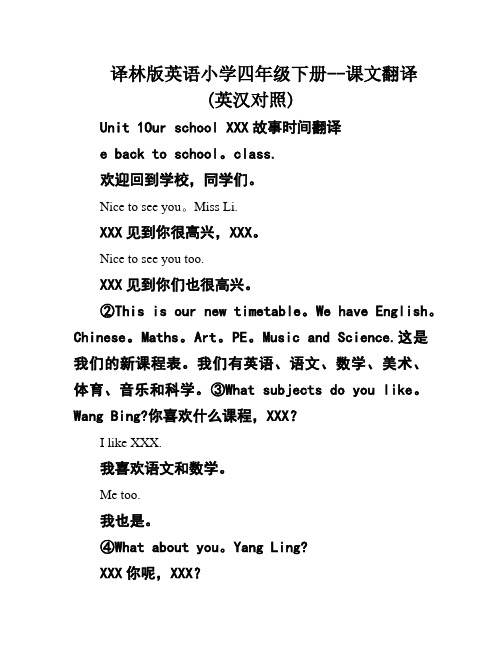
译林版英语小学四年级下册--课文翻译(英汉对照)Unit 1Our school XXX故事时间翻译e back to school。
class.欢迎回到学校,同学们。
Nice to see you。
Miss Li.XXX见到你很高兴,XXX。
Nice to see you too.XXX见到你们也很高兴。
②This is our new timetable。
We have English。
Chinese。
Maths。
Art。
PE。
Music and Science.这是我们的新课程表。
我们有英语、语文、数学、美术、体育、音乐和科学。
③What subjects do you like。
Wang Bing?你喜欢什么课程,XXX?I like XXX.我喜欢语文和数学。
Me too.我也是。
④What about you。
Yang Ling?XXX你呢,XXX?I like English。
It's fun.我喜爱英语。
它很风趣。
⑤Oh。
It's time for PE.哦!到上体育课的时间了。
Let's go to the playground.让我们去操场吧。
Unit 1 Cartoon time英语课文翻译①Hi。
Billy。
What lessons do we have this morning?你好,XXX。
今天上午我们有什么课?Hi。
Bobby。
It's Monday。
We have Music and Maths。
I like Music.译林版英语小学四年级下册--课文翻译(英汉比较)你好,XXX。
本日是礼拜一。
我们有音乐和数学。
我喜爱音乐。
②What lessons do we have this afternoon。
Sam?本日下战书我们有甚么课,XXX?We have PE and Science。
I like PE。
It's fun.我们有体育和科学。
译林英语四年级下册第八单元Unit8-How-are-you课件

Hello, this is Miss Li speaking... ...Can you come to school tomorrow?... ... See you tomorrow...
A:Hello, this is …(speaking). May I speak to…?
B:Hello, this is …(speaking).
What’s the matter? I have a headache.
A:What’s the matter? B:I have a ... A:I’m sorry to hear that.Take care.
I can talk about some illnesses.
Hello, this is Yang Ling speaking. May I speak to Miss Li? ...I can’t come to school today...I have a...
The hot dog in the box Is not lunch for the fox!
The hot dog in the box Is not lunch for the fox!
coffee o
dog
hot
not
sock
I can talk about some illnesses. I can make a telephone call. I know the sound of the letter “o”.
再见
有表情地分组对话,并 注意模仿语音语调噢!
两人一小组表演对话,比一比哪组表演的最棒噢!
1.复述Story time中的故事。 2.预习Cartoon time内容。
人教精通英语 四年级下册 课文
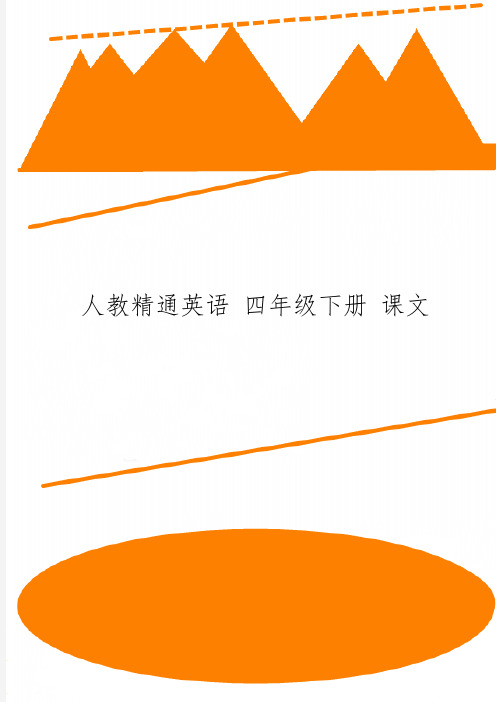
人教精通英语四年级下册课文Unit 1 Welcome to my new home!LESSON 1A: Hello,Li Yan ! 关于卧室B: Hi,Kate!Welcome to my new home.A: Look at my bedroom.B: Oh!There’s a new bed.A: And there’s a new desk and a new chair. LESSON 2 关于客厅A: Look at my living room.B: Wow!There’s a new TV.B: Oh!There are two sofas and four armchairs. A: And there are three kites and four balloons. LESSON 3 关于厨房A: Look at the kitchen.B: Wow!There is a new fridge.A: Look! Here’s a new table.B: And there are four new chairs.LESSON 4 关于书房A: Hello,Kate!B: Hi,Li Yan!Welcome to my home.B: Look! What’s in my study?A: Wow! There is a new computer.LESSON 5 客厅和浴室A: This is the living room . That’s the bathroom .B: What’s in the living room?A: Come and see.B: Oh, there’s a new DVD player .A: And there’s a big clock.Unit 2 There are forty students in our class.LESSON 7 体育高老师数一数A: Good afternoon ,boys and girls ! This is Mr Gao ,our new PE teacher.B: Good afternoon,Mr Gao!A: How many students are there in your class?B: Twenty-nine.A: Let’s count from 1 to 29!B: One,two,three... Twenty-eight,twenty-nine.LESSON 8 英语格林老师多少学生A: Good morning ,boys and girls ! This is Miss Green,our new English teacher. B: Miss Green.Welcome to our class!C: Good morning, class!How many students are there in your class?B: There are forty. Thirty boys. And only ten girls. LESSON 9 怀特老师多少老师A: Hello,Miss White!Welcome to our school!B: Thank you! How many teachers are there in your school? A: There are fifty.B: How about your school!A: There are sixty teachers in our school.LESSON 10 帮助孩子们有多少书包和书A: Hello,everyone!Let’s help children in need!B: How many bags do you have?C: We have seventy bags.A: How many books do you have?C: We have eighty books.LESSON 11 有多少钢笔和铅笔A: How many pens do you have?B: We have ninety pens.B: How many pencils do you have?A: We have one hundred pencils.Unit 3 What subject do you like best?LESSON 13 上午有多少节课?是什么课?A: How many lessons do you have today?B: We have six.A: How many lessons do you have in the morning ? B: We have four.A: What are they?B: They are maths,Chinese ,English and PE. LESSON 14 下午有多少节课?你喜欢音乐课吗?A: How many lessons do you have in the afternoon? B: We have two.A: What are they?B: They are music and art.A: Do you like music?B: Yes,I like it very much.LESSON 15 你最喜欢哪个学科?A: What subject do you like best?B: I like art best.A: Do you like music?B: No ,I don’t.LESSON 16 你们学习科学课吗?A: Do you study science?B: Yes,we do. And I like science best.A: Do you like English?C: Yes,I do.I like it best.LESSON 17 在英语课上做什么?A: What do you do in an English class? B: We listen and do.C: We speak and sing.D: We play and act.E: We do all kinds of things in English.A: That’s great.Unit 4 There are seven days in a week. LESSON 19 一个星期有多少天?A: Hi everyone! Give me a quick answer,please. B: OK!A: How many days are there in a week ?B: Seven.A: What’s the first day of the week?B: It’s Sunday.A: Excellent !LESSON 20 什么时候有体育课A: Welcome to our school! My name is Gao Wei. B: Glad to meet you,Gao Wei. Do you like sports? A: Yes,I do. I like PE very munch.B: When do you have PE lessons?A:We have PE lessons on Monday and Tuesday. LESSON 21 今天星期几?一周有几节英语课A:What day is today?B: It’s Wednesday .A: Mr Black will come to our school today.C: Good morning boys and girls!D: Good morning ! Welcome to our class!C: How many English lessons do you have in a week?D: We have three.C: When do you have English?D: We have English on Monday,Wednesday and Thursday.LESSON 22 一周多少天,是什么?A:Hello everyone! Let’s play a game!B: Great!A: How many days are there in a week?B: There are seven days in a week.A: What are they?B: They are Monday, Tuesday, Wednesday,Thursday,Friday,Saturday and Sunday. LESSON 23 在周末你们通常做什么A:What do you usually do on weekends?B: I usually go to the theme park on Saturdays.C: I usually go to see my grandpa and grandma on Sundays.D: I usually have music lessons on Saturdays.E: I usually go to the park on Sundays.Unit 5 What will you do this weekend?LESSON 25 关于野餐A: Mum,it’s Sunday today. Shall we have a picnic ?B: Yes,Let’s go and ask your dad.B: Wow,We have so many things for our picnic!A: What would you like,Lisa?B: I’d like a hamburger and a Coke,please. How about you,Mun and Dad? C: I’d like some bread and sausages.A: I’d like some cake and chicken.LESSON 26 奶奶家A: Hi ,Li Yan! Let’s go to see your grandma.B: Yes,Let’s go and ask your dad.B: Wow,We have so many things for our picnic!A: What would you like,Lisa?B: I’d like a hamburger and a Coke,please. How about you,Mun and Dad? C: I’d like some bread and sausages.A: I’d like some cake and chicken.LESSON 27 这个星期日做什么,放学路上A: I’ll have a party with my friends this Sunday. How about you ,Li Yan? B: I’ll go to my music lesson. What about you ,Kate?C: I’ll go to my art lesson.B: Do you like drawing?C: Yes,I do. How about you?B: I like singing..LESSON 28 这个星期日做什么,在学校A: What will you do on Sunday?B: I’ll read a new storybook.C: I’ll watch TV at home,How about you ,Yang Ming?D: I’ll play computer games at home.LESSON 29 这个星期日做什么,电话A: Hi,Jim! This is Peter.B: Hello,Peter!A: Tomorrow is Sunday. Would you like to go swimming with me? B: Sorry, I can’t go with you.A: What will you do tomorrow?B: I’ll go shopping with my mum. She’ll buy me a new jacket. A:That’s great! Goodbye!B:Bye!Unit 6 Would you like to take a trip?LESSON 31 去哪里?A: School is out in two days.B: Hooray!A: Would you like to take a trip?B: Certainly!A: Any ideas?B: I want to go to the theme park.C: We want to go to a farm.D: We want to go to the zoo.A: Good idea! How about the zoo and the farm? B: Cool!LESSON 32 动物园A: Come along,boys and girls!B: Wow!A: It’s a giraffe.B: Look! The giraffe is so tall!C: Yes,it has a long neck.B: Look! Miss Liu. What’s this in English?A: It’s a camel .B: Oh, the camel is so big!LESSON 33 水池里的动物A: Look! What’s that in English?B: It’s a seal.A: Good!A: Guess,Lisa! What’s that in English?B: It’s a dolphin.C: Look! The dolphin is dancing!LESSON 34 农场A: Here’s the farm,boys and girls!B: Oh, What a big farm!C: Look here !What are these in English?D: They are horses.如有侵权,请联系网站删除,仅供学习与交流C: What are these in English?D: They are cows.LESSON 35 农场草地A: Hello,boys and girls. Look there!B: What are those in English?C: They are sheep.D: No,they aren’t.They’re goats.【精品文档】第 11 页。
广州版四年级下册英语电子课文及单词表

课文及单词表 提供参考
精选课件
1
精选课件
2
精选课件
3
精选课件
4
精选课件
5
精选课件
6
精选课件
7
精选课件
8
精选课件
9
精选课件
10
精选课件
11
精选课件
12
精选课件
13
精选课件
14
精选课件
15
精选课件
16
精选课件
17
பைடு நூலகம்选课件
18
精选课件
19
精选课件
20
精选课件
21
精选课件
22
精选课件
23
精选课件
24
精选课件
25
精选课件
26
精选课件
27
精选课件
28
精选课件
29
精选课件
30
精选课件
31
精选课件
32
感谢亲观看此幻灯片,此课件部分内容来源于网络, 如有侵权请及时联系我们删除,谢谢配合!
pep小学英语四年级下课文及翻译

一起做练习Go to the library. 去图书馆Read a book. 读一本书Shhh... Be quiet! 嘘...安静!
去教师办公室Say hello. 说你好Hi, Miss White. 嗨,怀特老师。
Do you have a library? 你们有图书馆吗?Yes, we do. 是的,我们有。It's on the second floor. 它
This way, please. 请这边走。
learn 一起学This is my school. 这是我的学校。Cool! Do you have a music room? 真酷!你们有音乐教室吗?
一起说一说Welcome to our school! 欢迎来到我们的学校!This is my classroom. 这是我的教室。
它可真大!How many students are there in your class? 你们班上有多少学生?Forty-five students.
45个学生。Is that the computer room? 那是计算机房吗?No, it isn't. 不,不是。It's the teachers' office.
计算机dinner 晚餐 Let's chant 一起唱歌谣Sister, sister, can you see? 妹妹,妹妹你看见了吗?A
电视上有一只饥饿的老虎。Tiger, tiger, can you see? 老虎,老虎你看见了吗?Dinner for
晚餐给你,也给我。
英语基础模块下册Unit 8 课文

Richard Blechynden was a tea plantation owner. His dream was to sell his tea at the Fair. With the strong desire to expand his business, he had planned to give away free samples of hot tea to fair visitors.
13. whether...or... 是......还是......
Whether you like the idea or not, I'm going ahead with it.
无论你是否喜欢这个意见, 我将继续做下去。 •14. tip 原意为“顶端、小费”,现在多用于报刊、网络等传媒, 被译为“小贴士”,表示“提示、建议、小窍门”的意思。
One day an idea came to his mind. Why not make his tea into an iced drink? Then, he put a lot of ice into the brewed tea, mixed it with sugar and gave it away for free. The iced tea tasted good and cool, so that people all came here and asked for a drink.
make... into...把......制成...... put ... into... 把......放入...... give away 赠送,分发 mix...with... 把......同......相混合 for free 免费地
冀教英语四年级下册第8课课文朗读翻译重难点讲解
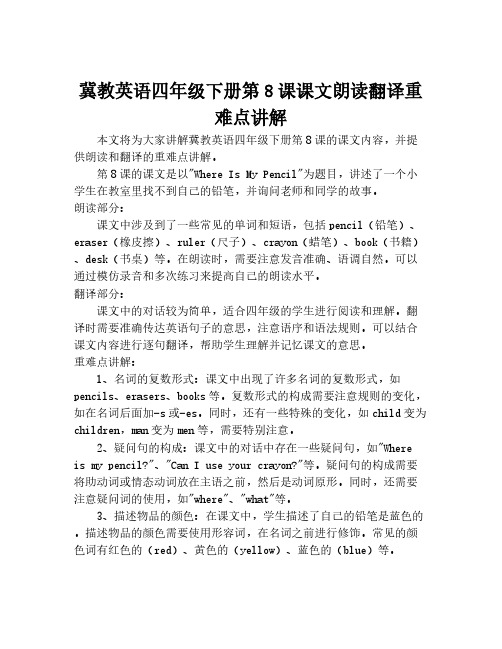
冀教英语四年级下册第8课课文朗读翻译重难点讲解 本文将为大家讲解冀教英语四年级下册第8课的课文内容,并提供朗读和翻译的重难点讲解。
第8课的课文是以"Where Is My Pencil"为题目,讲述了一个小学生在教室里找不到自己的铅笔,并询问老师和同学的故事。
朗读部分: 课文中涉及到了一些常见的单词和短语,包括pencil(铅笔)、eraser(橡皮擦)、ruler(尺子)、crayon(蜡笔)、book(书籍)、desk(书桌)等。
在朗读时,需要注意发音准确、语调自然。
可以通过模仿录音和多次练习来提高自己的朗读水平。
翻译部分: 课文中的对话较为简单,适合四年级的学生进行阅读和理解。
翻译时需要准确传达英语句子的意思,注意语序和语法规则。
可以结合课文内容进行逐句翻译,帮助学生理解并记忆课文的意思。
重难点讲解: 1、名词的复数形式:课文中出现了许多名词的复数形式,如pencils、erasers、books等。
复数形式的构成需要注意规则的变化,如在名词后面加-s或-es。
同时,还有一些特殊的变化,如child变为children,man变为men等,需要特别注意。
2、疑问句的构成:课文中的对话中存在一些疑问句,如"Where is my pencil?"、"Can I use your crayon?"等。
疑问句的构成需要将助动词或情态动词放在主语之前,然后是动词原形。
同时,还需要注意疑问词的使用,如"where"、"what"等。
3、描述物品的颜色:在课文中,学生描述了自己的铅笔是蓝色的。
描述物品的颜色需要使用形容词,在名词之前进行修饰。
常见的颜色词有红色的(red)、黄色的(yellow)、蓝色的(blue)等。
通过朗读、翻译和重难点讲解,可以帮助学生更好地理解和掌握第8课的课文内容。
同时,也需要教师和家长的辅助和引导,通过反复练习和互动交流,提高学生的英语能力和应用能力。
四年级英语教案 Lesson 8 First, Second, Third-国赛一等奖
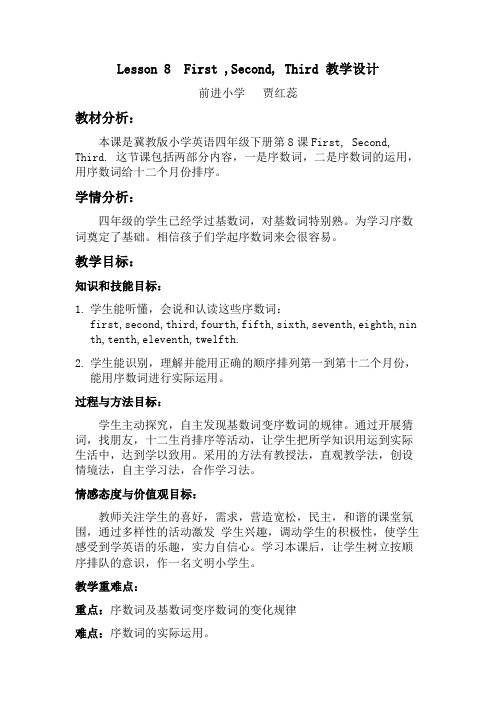
Lesson 8 First ,Second, Third 教学设计前进小学贾红蕊教材分析:本课是冀教版小学英语四年级下册第8课First, Second, Third. 这节课包括两部分内容,一是序数词,二是序数词的运用,用序数词给十二个月份排序。
学情分析:四年级的学生已经学过基数词,对基数词特别熟。
为学习序数词奠定了基础。
相信孩子们学起序数词来会很容易。
教学目标:知识和技能目标:1.学生能听懂,会说和认读这些序数词:first,second,third,fourth,fifth,sixth,seventh,eighth,nin th,tenth,eleventh,twelfth.2.学生能识别,理解并能用正确的顺序排列第一到第十二个月份,能用序数词进行实际运用。
过程与方法目标:学生主动探究,自主发现基数词变序数词的规律。
通过开展猜词,找朋友,十二生肖排序等活动,让学生把所学知识用运到实际生活中,达到学以致用。
采用的方法有教授法,直观教学法,创设情境法,自主学习法,合作学习法。
情感态度与价值观目标:教师关注学生的喜好,需求,营造宽松,民主,和谐的课堂氛围,通过多样性的活动激发学生兴趣,调动学生的积极性,使学生感受到学英语的乐趣,实力自信心。
学习本课后,让学生树立按顺序排队的意识,作一名文明小学生。
教学重难点:重点:序数词及基数词变序数词的变化规律难点:序数词的实际运用。
教学准备:课件,录音,月份及序数词单词卡片,十二生肖头饰教学过程:Step.1 Greeting and revision------ Good afternoon,teacher!------Sit down please.-----Thank you ,teacher.Let’ review the months of the year.Let” sing loudlytogether.(设计意图:师生问候营造英语课堂氛围。
(完整word版)PEP小学四年级下册英语课文及翻译_3483

PEP四年级下册英语课文及翻译Unit 1Our schoolALet ’ s learnplayground 操场 library 图书室teacher’ s office教师办公室garden花园canteenWhere is the canteen?食堂在哪里?It ’ s on the first floor它.在一楼。
Let ’ s doGo to the garden. Water the flowers.Go to the library. Read a story-book.Go to the cinema. Eat some noodles.Go to the teacher’ s office. Hand in your homework. Go to the playground. Play football.Let ’ s talkChen: Welcome to our school!欢迎来我们的学校。
This is the teacher ’ s office这.是教室办公室。
That is my classroom那.是我的教室。
Visitor: How many students are there in your class?你们班有多少个学生?食堂Chen: Forty-five.四十五。
Visitor: Do you have a library?你们有图书室吗?Chen: Yes.Visitor: Do you have lunch at school?你们在学校吃午餐吗?Chen: Yes! The canteen is on the first floor. This way , please.是的。
食堂在一楼。
这边请。
Look! This is our playground.看!这是我们的操场。
Visitor: Oh! Your school is beautiful.哦!你们的学校很优美。
冀教英语四年级下册第8课课文朗读翻译重难点讲解

冀教英语四年级下册第8课课文朗读翻译重难点讲解课文:The Lion and the MouseOnce upon a time, a lion was sleeping in the forest. Suddenly, a mouse ran across the lion's nose. The lion opened his eyes and caught the mouse with his big paw."Please don't eat me! I am small and weak. But one day, I might help you," said the mouse.The lion laughed and let the mouse go. He didn't think the tiny mouse could ever help him.One day, hunters caught the lion and tied him to a tree. The lion roared and tried to break free, but the rope was too strong.The mouse heard the lion's roar and ran to help. He started gnawing at the rope with his sharp teeth. After a while, the rope broke and the lion was free."Thank you, little mouse. You have saved my life," said the lion. From that day on, the lion and the mouse became good friends.翻译:《狮子和老鼠》从前,有一只狮子在森林里睡觉。
四年级下册第8课
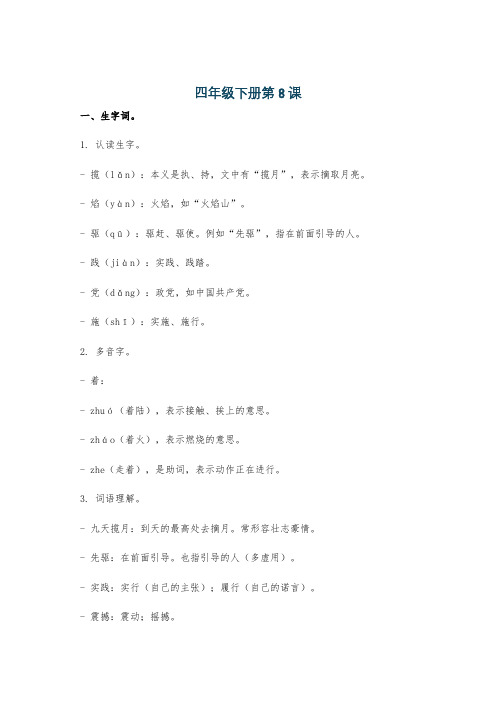
四年级下册第8课一、生字词。
1. 认读生字。
- 揽(lǎn):本义是执、持,文中有“揽月”,表示摘取月亮。
- 焰(yàn):火焰,如“火焰山”。
- 驱(qū):驱赶、驱使。
例如“先驱”,指在前面引导的人。
- 践(jiàn):实践、践踏。
- 党(dǎng):政党,如中国共产党。
- 施(shī):实施、施行。
2. 多音字。
- 着:- zhuó(着陆),表示接触、挨上的意思。
- zháo(着火),表示燃烧的意思。
- zhe(走着),是助词,表示动作正在进行。
3. 词语理解。
- 九天揽月:到天的最高处去摘月。
常形容壮志豪情。
- 先驱:在前面引导。
也指引导的人(多虚用)。
- 实践:实行(自己的主张);履行(自己的诺言)。
- 震撼:震动;摇撼。
- 苍穹:天空。
- 里程碑:比喻在历史发展过程中可以作为标志的大事。
二、文章结构与内容。
1. 结构。
- 第一部分(第1 - 3段):简要叙述了中华民族为了实现飞离地球、遨游太空的千年梦想所进行的不断尝试,重点描述了明代的万户所尝试的火箭飞行。
- 第二部分(第4 - 7段):叙述了新中国成立以来,中国的航天事业呈现的勃勃生机,从第一颗人造卫星的成功发射到“神舟五号”载人飞船的发射成功,中华民族几千年的梦想,终于在今天变成了美好的现实。
- 第三部分(第8段):简要总结了中华民族不断追求航天梦想的意义。
2. 主要内容。
- 课文叙述了中华民族几千年来为实现飞离地球、遨游太空的美好梦想所进行的不断的尝试和追求,重点记述了新中国成立以来,中国航天事业的蓬勃发展,在广大科技工作者、工人和解放军官兵的共同努力下,“神舟五号”的成功发射,标志着我国已经成为世界上第三个独立掌握载人航天技术的国家,载人航天的千年梦想终于实现了。
文章热情赞扬了中国航天工作人员热爱祖国,团结合作、默默奉献、勇于探索、锲而不舍的科学精神。
三、重点句子与段落分析。
1. 重点句子。
- 1、下载文档前请自行甄别文档内容的完整性,平台不提供额外的编辑、内容补充、找答案等附加服务。
- 2、"仅部分预览"的文档,不可在线预览部分如存在完整性等问题,可反馈申请退款(可完整预览的文档不适用该条件!)。
- 3、如文档侵犯您的权益,请联系客服反馈,我们会尽快为您处理(人工客服工作时间:9:00-18:30)。
四年级下册英语第8课课文
四年级下册英语第8课课文
一、课文内容
春天的一天,小明和他的朋友们决定去郊外野餐。
他们带上了食物、
饮料和足球。
天气很好,阳光明媚,鸟儿在欢快地歌唱。
他们找了一个草地坐下,开始享受美食。
他们吃着水果、三明治,喝
着果汁、牛奶,聊天、开心笑着。
突然,小明看见一只小狗,它正追着一个篮球滚下坡。
小明忍不住笑
了起来,他觉得这个小狗真可爱。
过了一会儿,他们决定玩足球。
小明和他朋友们激动地踢起了球。
他
们跑来跑去,奔腾的汗水湿透了他们的衣服。
不久,天空乌云密布,开始下起了小雨。
他们只好收拾起东西,准备
回家了。
他们急忙往回走,生怕被大雨淋湿。
回到家,小明感到非常开心。
他觉得这是他最美好的一天。
在野餐中,他们不仅享受美食,还拥有了快乐的时光。
二、生词解析
1. 野餐(yěcān):在户外用餐,一般指在自然环境中的休闲用餐。
2. 足球 (zúqiú):一种球类运动,通常由两队各11名球员进行比赛。
3. 篮球 (lánqiú):一种在篮筐上投掷并得分的运动,一般由两队各5名球员进行比赛。
4. 追着(zhuīzhe):向着某个方向追赶,不停地追逐。
5. 奔腾(bēnténg):形容奔跑的样子,迅速而有力。
6. 湿透(shītòu):完全被液体浸湿,使物体内外都湿润。
三、课文主题
这篇课文主要讲述了小明和他的朋友们在春天的一天决定去郊外野餐的故事。
他们在野餐中玩足球,享受美食,并且经历了小雨临时改变计划的情景。
通过这个故事,作者传达了开心快乐的情绪以及对大自然的热爱。
四、课文感想
这篇课文给我留下了美好的印象。
它让我想起了小时候和朋友们一起玩耍、享受阳光的美好时光。
课文中的小明和他的朋友们展现出了快
乐和团结的力量,通过野餐和游戏,他们建立了深厚的友谊。
野餐是一种与自然亲近的活动,也是一种与朋友们共同享受快乐时光的方式。
无论是在草地上野餐,还是在阳光明媚的日子里玩耍,我们都可以通过这些活动感受到大自然的美好和朋友的温暖。
这篇课文教会了我享受当下、珍惜与朋友们相处的时光。
无论是在忙碌的学习生活中,还是闲暇的周末,与朋友们一起度过时光是非常重要的。
通过这样的活动,我们可以打破常规、放松心情,培养团队合作的能力,同时也能享受与大自然融为一体的美妙感受。
总而言之,这篇课文让我明白了快乐的源泉不仅在文化知识的积累,也在于与朋友们共度美好时光、与大自然亲近的体验。
我希望将来能继续享受野餐的乐趣,与朋友们共同留下更多美好的回忆。
